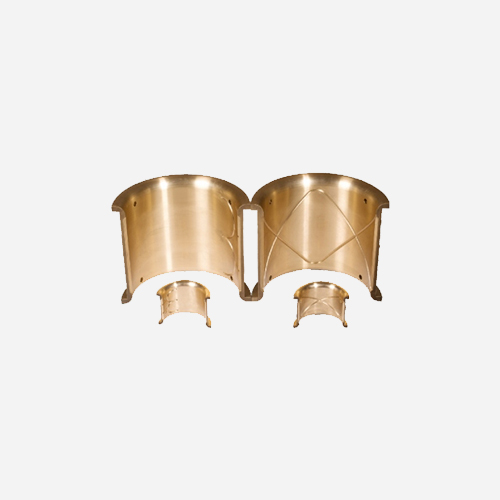HANNOVER MESSE 2016
In April 2016, the world's largest automation exhibition-Hannover Germany was held in Hannover, Germany. Jiaerda Machinery sent colleagues from the US branch and the marketing department of the headquarters to participate. This is the first time that Jiaerda Machinery has participated in the Hannover Automation Exhibition in Germany.
What is the difference between tin bronze and aluminum bronze? C95500 VS C95400
C95500
1. Good plasticity, not brittle at low temperature, can be welded well with bronze, steel, and other alloys, good fiber weldability, high corrosion resistance in the atmosphere, fresh water, and seawater, stable and cold to the effect of caustic soda and chloride, Hot pressure processing, cannot be strengthened by heat treatment, usually used in the annealed and work-hardened state, at this time, there are a high yield limit and elasticity.
- QSi3-1 silicon bronze rod chemical composition: copper Cu: balance tin Sn: ≤0.25 zinc Zn: ≤0.5 lead Pb: ≤0.03 lead Pb: ≤0.03 nickel Ni: ≤0.2 iron Fe: ≤0.3 manganese Mn: 1.0-1.5 Silicon Si: 2.7-3.5 Note: ≤1.1 (impurity)
- QSi3-1 Silicon Bronze Rod Mechanical Properties: Tensile Strength: ≥490 Elongation: ≥10 Elongation: ≥13 Note: The longitudinal chamber of the rod. The high temperature and heat resistance of the alloy. The abrasion resistance of aluminum bronze and its corrosion resistance in the atmosphere, seawater, seawater carbonic acid, and most organic acids.
2. Stable and reliable quality
It is mainly used to make elastic components, wear-resistant parts and metal meshes, etc. It is mainly used in the aviation industry as the diaphragm of combined airspeed gauges, intake pressure gauges, etc. QSn7-O, with high strength, hardness and high It has high elasticity and wear resistance, high corrosion resistance in the atmosphere, freshwater, and seawater, easy to weld, and can be stamped.
3. Heat treatment technology experiment.
The hardness performance of aluminum bronze alloy materials is related to many factors, such as pouring temperature, cooling rate, purification degree, heat treatment technology, etc., during which the correct selection and matching of heat treatment technical parameters are one of the first ways to improve the hardness of alloy materials. Same as aluminum alloy, copper alloy is generally melted in a crucible furnace so that the copper liquid is not directly fuel and air, and the metal is oxidized and damaged.
C95400
Copper alloy or solid processed material of opposite sex. According to the geometric shape, it is divided into round rods and heterosexual rods. According to the production method, it is divided into extruded rods and drawn rods. According to the performance, it is divided into hard state rod and hot state rod. According to the alloy name, it is divided into red copper rod, alloy copper rod, and so on. It has high strength, good wear resistance, and good corrosion resistance. It can be hot processed, welded but not easily brazed. It is mostly used to manufacture high-strength, wear-resistant parts, such as bearings, bushings, gears, eddy currents, etc.; It can also manufacture connecting nozzles, flanges, flat rockers, brackets, etc.
In C95400 aluminum bronze, Al content: 8.0~11.0%; Mn content: 0.5~2.5%; Ni content: 4.0~6.0%; Sn content: 0.2%; Zn content: 0.5%; Fe content: 4.0~6.0; Pb content: 0.05%; Si content: 0.25%; sum of impurities: 1.2%; Cu: balance. It is aluminum bronze containing iron and manganese elements, and the aluminum content is between 8.0% and 11.0%.
- Simple aluminum bronze refers to a copper-aluminum binary alloy containing only aluminum
- Complex aluminum bronze refers to a multi-element alloy that contains elements such as iron, nickel, manganese, and silicon in addition to aluminum. There are 26 grades of processed aluminum bronze in the American ASTM standard, and 18 casting alloys. The basic alloy composition of aluminum bronze is Cu-Al, Cu-Al-Fe, Cu-Al-Ni, Cu-Al-Fe-Ni, Cu-Al-Fe-Ni-Mn, etc.
The difference between tin bronze and aluminum bronze:
Adding certain alloying elements (such as zinc, tin, aluminum, beryllium, manganese, silicon, nickel, phosphorus, etc.) to pure copper forms a copper alloy. The copper alloy has good electrical conductivity, thermal conductivity, and corrosion resistance, as well as high strength and wears resistance.
Tin bronze and aluminum bronze in copper alloys differ in composition and use.
- Tin bronze A copper-based alloy with tin as the main alloying element is called tin bronze. In tin bronze used in industry, the tin content is mostly between 3% and 14%. Tin bronze with a tin content of less than 5% is suitable for cold working; tin bronze with a tin content of 5% to 7% is suitable for hot working; tin bronze with a tin content of more than 10% is suitable for casting. Tin bronze is widely used in shipbuilding, chemical industry, machinery, instrumentation, and other industries. It is mainly used to manufacture bearings, bushings, and other wear-resistant parts, springs, and other elastic elements, as well as anti-corrosion and anti-magnetic parts.
- Aluminum bronze A copper-based alloy with aluminum as the main alloying element is called aluminum bronze. The mechanical properties of aluminum bronze are higher than brass and tin bronze. The aluminum content of practical aluminum bronze is between 5% and 12%.






